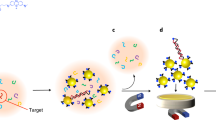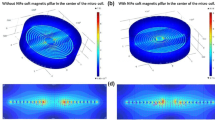Abstract
In this paper, we investigated the applicative using of thermal-magnetic biosensor (TMAGS) for DNA detection. TMAGS is a planar device composed by a primary microcoil able to generate a magnetic field which induces a voltage equal and opposite on two secondary coils. The presence of magnetic material on one of the two secondary coils causes a variation of induced magnetic field especially in the area where the magnetic material is located. In particular, here, we studied the compatibility of two different typologies of beads (MNB1 and MNB2) as magnetic labels towards DNA hybridization process in TMAGS device. These two types of beads differ in size (1 and 0.1 μm), magnetic material location (core or shell), and chemical surface proprieties (electrostatic or covalent bonds possible). In particular, in the first part of the work, we investigate the response of the TMAGS architectures versus the two-bead topology and we found MNB1 exhibits a better output voltage signal (on average 30% higher than the voltage signal of MNB2). On the contrary, when they are employed as magnetic label in a real DNA hybridization process in TMAGS device, only MNB2 typology gives positive results. We ascertain that both the size of the bead and the nature of the chemical bond between the magnetic label (beads) and the DNA target, that must be a covalent bond, play a key role on the success of hybridization reaction. Therefore, a compromise between magnetic content (bead size) and nature of bead-target chemical bond must be selected for the future employment of these devices in molecular detection.





Similar content being viewed by others
References
Chin, C. D., Chin, S. Y., Laksanasopin, T., & Sia, S. K. (2013). Low cost microdevice for point-of-care testing. In D. Issadore & R. M. Westervelt (Eds.), Point of care diagnostics on a chip. Berlin Heidelberg: Springer-Verlag.
Jung, W., Han, J., Choi, J. W., & Ahn, C. H. (2007). Point-of-care-testing (POCT) diagnostic systems using microfluidic lab-on-a-chip technologies. Microelectronic Engineering, 132, 46–57.
Su, W., Gao, X., Jiang, L., & Qin, J. (2015). Microfluidic platform towards point-of-care diagnostics in infectious diseases. Journal of Chromatography A, 1377, 13–26.
Ahmad, F., & Hashsham, S. A. (2012). Miniaturised nucleic acid amplification systems for rapis and point-of-care diagnostics. A review – Analytica Chimica Acta, 733, 1–15.
Higuchi, R., Dollinger, G., Walsh, P. S., & Griffith, R. (1992). Simultaneous amplification and detection of specific DNA sequences. Biotechnology, 10, 413–417.
Wilhelm, J., & Pingoud, A. (2003). Real-time polymerase chain reaction. Chem BioChem., 4, 1120–1128.
Foglieni, B., Brisci, A., San Biagio, F., Di Pietro, P., Petralia, S., Conoci, S., Ferrari, M., & Cremonesi, L. (2010). Molecular diagnostics on a lab-on-chip device. A new advanced solution for mutation detection in gene-diseases. Clinical Chemistry and Laboratory Medicine, 48, 329–336.
Santangelo, M. F., Sciuto, E. L., Busacca, A. C., Petralia, S., Conoci, S., & Libertino, S. (2015). SiPM as miniaturised optical biosensor for DNA-microarray applications. Sensing and Biosensing Research, 6, 95–98.
Santangelo, M. F., Sciuto, E. L., Busacca, A. C., Petralia, S., Conoci, S. & Libertino, S. (2016). Novel Si-based technologies for bio-sensing applications. IEEE Journal of Selected Topics in Quantum Electronics, 22(3)
Almassian, D. R., Cockrell, L. M., & Nelson, W. M. (2013). Portable nucleic acid and thermocycler. Chemical Society Reviews, 42, 8769.
Mohammeda, M. I., Haswellb, S., & Gibsona, I. (2015). Lab-on-a-chip or chip-in-a-lab: challenges of commercialization lost in translation. Procedia Technology, 20, 54–59.
Libertino, S., Conoci, S., Scandurra, A., & Spinella, R. C. (2013). Biosensor integration on Si-based devices: feasibility studies and examples. Sensors & Actuators B: chemical, 179, 240–251.
Conoci, S., Mascali, A., & Pappalardo, F. (2014). Synthesis, DNA binding properties and electrochemistry to an electrode-bound DNA of a novel anthracene-viologen conjugate. RSC Advances, 4, 2845–2850.
Petralia, S., Castagna, M. E., Cappello, E., Puntoriero, F., Trovato, E., Gagliano, A., & Conoci, S. (2015). A miniaturized silicon based device for nucleic acids electrochemical detection. Sensing and Biosensing Research, 6, 90–94.
Ghionea, S., Dhagat, P., & Jander, A. (2008). Ferromagnetic resonance detection for magnetic microbead sensors. IEEE Sensors Journal, 8, 896.
Serre, C., Martìnes, S., Perez-Rodrìguez, A., Morante, J. R., Esteve, J., & Montserrat, J. U. (2006). Si technology based microinductive devices forbiodetection applications. Sensors and Actuators A, 132, 499–505.
Baglio, S., Castorina, S., & Savalli, N. (2005). Integrated inductive sensors for the detection of magnetic microparticles. IEEE Sensors Journal, 5, 372–375.
Andò, B., Baglio, S., Beninato, A., Fallica, G., Marletta, V., & Pitrone, N. (2009). Analysis and design of inductive biosensors for magnetic immunoassay. XIX IMEKO World Congress Fundamental and Applied Metrology September Lisbon, Portugal (pp. 6–11).
Castagna, M. E., Petralia, S., Amore, M. G., Cappello, E., Beninato, A., Sinatra, V., Baglio, S., & Conoci, S. (2015). A novel silicon based mags-biosensor for nucleic acid detection by magnetoelectronic transduction. Sensing and Biosensing Research, 6, 85–89.
Beninato, A., Sinatra, V., Tosto, T., Castagna, M. E., Petralia, S., Conoci, S., & Baglio, S. (2016). Inductive integrated biosensor with extended operative range for detection of magnetic beads for magnetic immunoassay. IEEE Transactions on Instrumentation and Measurements, 66(Issue 2), 348–359.
Palmieri, M., Alessi, E., Conoci, S., Marchi, M., & Panvini, G. (2008) Develop the “In-Check” platform for diagnostic applications. Proceedings of SPIE, 6886, Microfluidics, BioMEMS, and Medical Microsystems VI, 6886–01.
Mohan, S. S., del Mar Hershenson, M., Boyd, S. P., & Lee, T. H. (1999). Simple accurate expressions for planar spiral 2 inductances. IEEE Journal od Solid-State Circuits, 34, 1419–1424.
Author information
Authors and Affiliations
Corresponding author
Rights and permissions
About this article
Cite this article
Petralia, S., Castagna, M.E., Beninato, A. et al. Magnetic Beads Compatibility as DNA Hybridization Labels in Integrated Thermal-Magnetic Biosensor. BioNanoSci. 7, 485–491 (2017). https://doi.org/10.1007/s12668-017-0410-6
Published:
Issue Date:
DOI: https://doi.org/10.1007/s12668-017-0410-6




